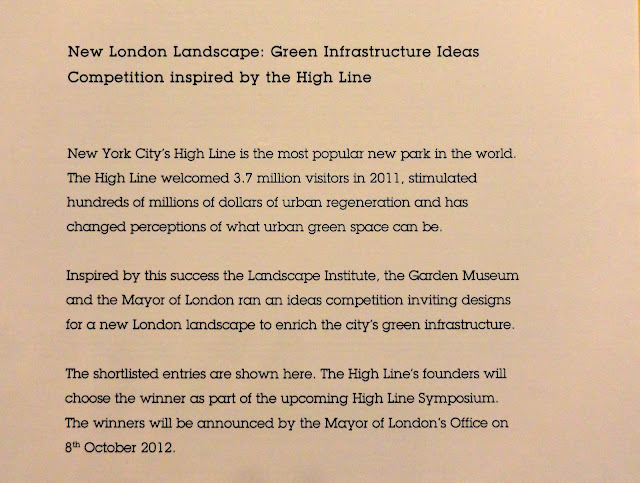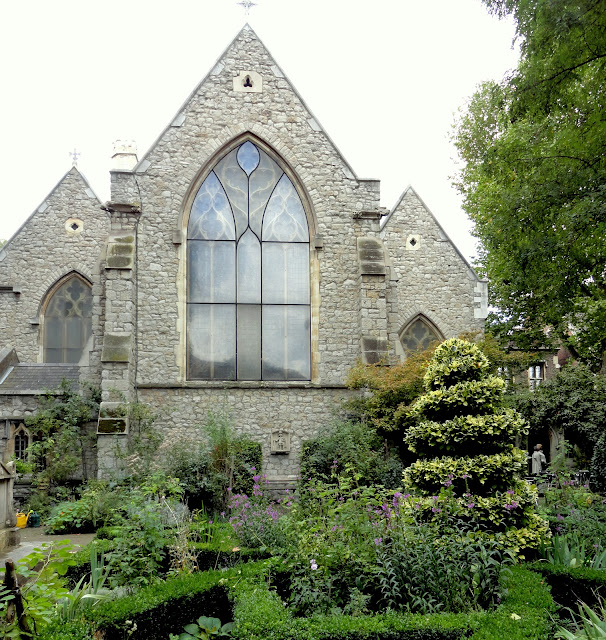Tuesday, December 11, 2012
The Garden Museum, London
While Andrew visited the Imperial War Museum (during our September trip to London) I chose something a little different, the Garden Museum. What, you’ve never heard of it? I hadn’t either. Luckily Andrew discovered it when researching museums for the trip. From their website: “The Museum was set up in 1977 in order to rescue from demolition the abandoned ancient church of St Mary’s which is the burial place of John Tradescant (c1570 – 1638), the first great gardener and plant-hunter in British history. His magnificent and enigmatic tomb is the centerpiece of a knot garden planted with the flowers which grew in his London garden four centuries ago.”
The Museum is located on the south bank of the Thames opposite The Palace of Westminster. I spent quite awhile just exploring the informal garden that surrounds the building.
I love the planters for secure bike parking.
By this time I was getting quite used to seeing tombs and gravestones, I think the only day of the entire vacation that I didn’t was the day we went to the Kew.
There was a sign in the garden explaining the plant choices were made based on conditions such as free draining soil, drying winds from the river, and lack of accessible watering. That's why there were so many agaves! Here are several small pups struggling to get established. A couple look like they’ve been stepped on.
Of course I always have to see where any path leads...
Smoky! I love the subdued colors.
I don't think I've ever seen a completely white kniphofia.
This was at the end of the path, certainly a way to make a chain link fence look a little more substantial.
Little things like this remind me I'm not in Oregon.
Another agave and an echium too!
Time to go inside...
The temporary exhibit...
The metal box is called a Vasculum, used for carrying plant specimens. This one isn't all that old, dating from the 1980's according to the signage. They also acknowledged that while this aluminium version is much lighter than the tin originally used, it is still somewhat cumbersome and most botanists now use plastic bags and boxes.
Wardian Case from around 1890.
Love the graphics on these old catalogues!
There was another exhibit on the main floor of the building, this one a competition inspired by NYC's successful High Line. This was a tiny bit odd for me because this vacation was almost instead a trip to NYC, where I would have been visiting the High Line itself, instead I was standing in London reading about designs proposed for their version. Here are a couple of links if you want to learn more about the design challenge: ‘A High Line for London: Green Infrastructure ideas competition for a new London landscape’ and 'High Line fever'...
I really enjoyed looking over the boards and reading about the concepts.
I later learned none of my favorites (pictured) won, a idea called the "Urban Mushroom Scheme" won the competition.
There was a cafe in the museum as well, and the food smelled so good! However there was no time for sitting down!
I needed to go out to explore the courtyard garden!
The sign above reads: "The Museum’s garden was created in 1980. At its heart is a knot garden designed by the Museum’s President, The Dowager Marchioness of Salisbury (who was then also re-making the gardens at Hatfield House, Hertfordshire). The reason for the seventeenth-century spirit of the design is that our garden also houses the tomb of the great plant-hunters, gardeners and collectors, John Tradescant the Elder (c.1570-1638) and Younger (1608-1662), the rediscovery of which originally inspired the creation of a museum of garden history in the deconsecrated, and then derelict, church of St Mary-at-Lambeth.
The knot garden and its surrounds are planted with species introduced by the Tradescants - such as the scarlet runner bean, red maple and tulip tree - and many others grown by them in their Lambeth garden. It is not only historically significant but also a lush and beautiful spot in the centre of London, cared for by a small horticultural team of staff and volunteers."
The church is quite beautiful from every angle.
This tomb held the remains of Captain William Bligh as well as his wife, Elizabeth and their sons William and Henry who died March 21 1795 at the age of 1 day. Their grandchild W. Bligh Barker who died in 1805 at the age of 3 yrs is also buried here.
From the side...
This decoratively carved tomb is that of John the Tradescent (Younger and Elder)...
A final glance at the garden before heading back inside...
Such great decorative details!
The upstairs of the museum/church is where the permanent collections are held.
Measuring devices...for seeds and I think the wooden ones with the holes were for bulbs.
I love old advertising and magazine covers...
Those machines make my reel mower look streamlined...
Nice that they included the ubiquitous garden gnome.
Finally, can you guess what this is?
Of course...
There was also a small gift shop on the first floor doing a brisk business, but I didn't take any pictures there. I really enjoyed my visit to the Garden Museum, and I hope you did too...
Labels:
London 2012
Subscribe to:
Post Comments (Atom)






















































No comments:
Post a Comment